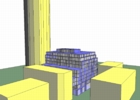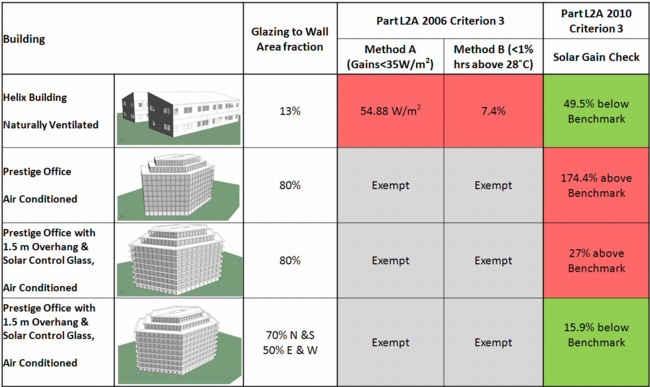Dynamically achieving Part L compliance

Dynamic simulation modelling has many advantages over SBEM in achieving Part L compliance — especially in assessing the effects of solar gain in the Summer. Michael Pollock discusses the benefits of incorporating dynamic simulation into the design process.
Ever since the 2006 version of Part L of the Building Regulations was introduced, building-services engineers have discussed and debated the differences and respective pros and cons of whether to use SBEM or DSM (dynamic simulation modelling) for compliance. However, as passing Part L gets harder and harder, the introduction of the 2010 update begs the question will there be a much greater use of DSM to maximise calculation accuracy and opportunities for passing Part L?
SBEM (Simplified Building Energy Model) is the compliance procedure/computer program developed by BRE for the Government. DSM (dynamic simulation model) tools are commercial dynamic thermal modelling tools which, like SBEM, comply with the NCM (National Calculation Methodology). The difference is in how the calculations are undertaken and the flexibility allowed with regards to building geometry, features and HVAC systems.
SBEM calculates monthly energy use and carbon-dioxide emissions based on a tabular description of the building geometry, construction, use and HVAC/lighting equipment. A free, basic interface to the program, iSBEM, is available from the Government, and a number of alternative commercially developed interfaces are also available. IES offers a free 3D model-based interface to SBEM, which also integrates with our DSM tool.
DSM uses detailed geometry from 3D models, real site weather data and simulates at hourly (or sub-hourly) intervals throughout the entire year. By analysing the energy performance in this manner, as opposed to the monthly average calculated by SBEM, the results are commonly more accurate and allow modelling of large, complex buildings such as offices, schools, hospitals, airports, schools and retail outlets.
Common features that DSM is perfectly suited to assess include large multi-zoned designs, natural and/or demand-controlled ventilation, external and/or internal solar shading and the transfer of solar radiation in highly glazed spaces.
The 2010 Building Regulations highlight some of these differences, and make them even more important than ever. With Part L 2010, the trend towards increased technicality is now set. The days of just putting default figures into SBEM are passing, and building designers now need to take more elements into account, in more detail and at an holistic level. Tools that allow them to understand a building’s performance at this level of detail will enable them to develop more innovative designs and ultimately lead to more energy efficient buildings.
One of the main changes within Part L 2010 to be affected by the differences between SBEM and DSM is the significant revision to Criterion 3 (limiting the effects of solar gains in summer). Taking a much fairer approach, the previous methods of demonstrating compliance have been removed and replaced by a new solar intensity test.
Designers must show that aggregated solar gains between April and September do not exceed a benchmark level. In addition, no building is exempt; all regularly occupied non-transient rooms must be included, regardless of whether they are air conditioned or not (air-conditioned rooms were exempt from the 2006 Criterion 3 overheating test).
To assess the implications of Criterion 3 and these new benchmarks we undertook a case study across several different building types, all in London, with different glazing levels. The results confirmed our first impressions — that air-conditioned buildings with high levels of aesthetic glazing, which would previously have been exempt, are now very tough to pass.

As the table shows a heavily glazed air-conditioned office without any active means of limiting solar gains fails by a significant margin. Adding design measures to limit solar gains, such as shading devices and specifying solar control glass, enables solar gain to be brought much closer to the benchmark level. However, it is not until the glazing levels on the key problem East and West faces is significantly reduced that compliance is achieved.
This study was undertaken using IES’s VE-DSM software, which, through its link to our solar shading module SunCast, allowed us to accurately take into account a wide range of passive and active solar-shading measures — including self shading, solar penetration throughout the building and surrounding buildings. Unfortunately, it is not possible to call upon SBEM for this level of help, as such features cannot be included easily and it does not track the path of the Sun. It is only possible to include limited solar-shading measures within SBEM — such as blinds, glass type changes and static shading co-efficient values to approximate external solar shading devices.
As demonstrated above, when trying to achieve compliance with Criterion 3 in circumstances when such measures make the difference between a pass or not, a dynamic-simulation (DSM) route should definitely be considered. As a final approved version of SBEM for Part L 2010 is not yet available, we have not been able to take this analysis further and make a direct Part L 2010 comparison of SBEM results to approved DSM tools. However, we will do this in the future, so sign up to our Part L e-mail list to get the latest updates.
The other main argument for using DSM over SBEM, is that dynamic thermal simulation is a design tool adapted for compliance, meaning that DSM can easily be incorporated into the design process — allowing both compliance and real building performance to be considered alongside each other right from early stages in the process. And, it is at these stages when the most difference to energy efficiency and, therefore, easy achievement of Part L 2010 compliance can be made.
To get the best results, right from the early stages of a project, designers should be aware of the holistic implications and tradeoffs design options will have with regards to natural daylight, solar gain, fabric loss and facade design. This integrated design and analysis approach will have a much larger role to play going forward. As DSM tools work from 3D models of the building, it is easier to make quick compliance checks along with way using the same model, rather than having to separately input data into SBEM tools.
There are other reasons which you may want to consider, but from my perspective, it is for these reasons that I think there is likely to be a much greater use of DSM in the future so as to maximise calculation accuracy and opportunities for passing Part L.
Michael Pollock is senior project consultant with Integrated Environmental Solutions (IES).







